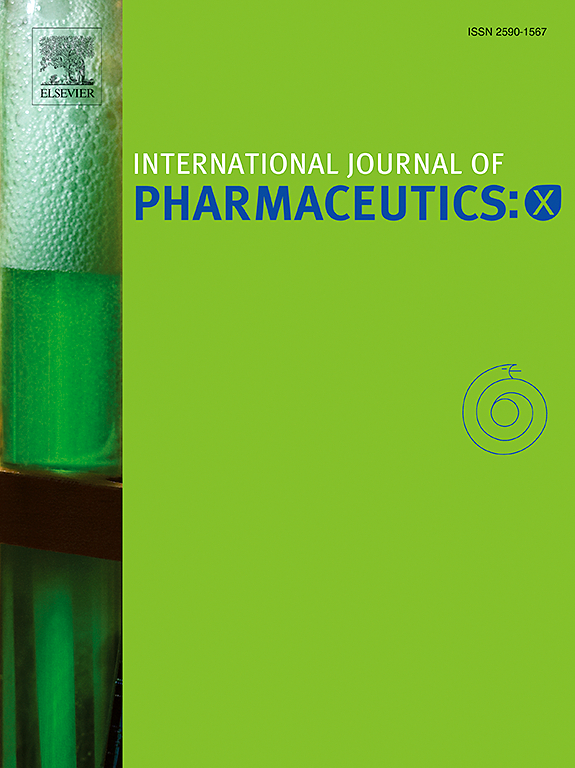Life cycle assessment of pharmaceutical tablet manufacturing: A comparative analysis and systems model integration framework
IF 6.4
2区 医学
Q1 PHARMACOLOGY & PHARMACY
引用次数: 0
Abstract
Pharmaceutical drug products in the form of tablets are produced via a series of manufacturing steps, transforming powder blends to compacted granules with carefully selected properties such as tensile strength and dissolution time. Typical oral solid dosage form (OSD) manufacturing processes include direct compression (DC), roller compaction (RC), high shear granulation (HSG) and continuous direct compression (CDC). Design of each process step is required to achieve end-product quality for the specific material properties and available equipment, although design decisions are typically made without a quantitative understanding of the impact on product environmental footprint. Using a ‘cradle-to-gate’ life cycle assessment (LCA) methodology, a quantitative sustainability comparison has been made between standard OSD manufacturing platforms across different production scales. The results demonstrate that for small batch sizes, DC produces tablets with the lowest carbon footprint, however at larger batch sizes, CDC is the most carbon efficient manufacturing platform. Due to the high carbon footprint of the active pharmaceutical ingredient (API), formulation process yields had the greatest impact on overall carbon footprint, although emissions from equipment energy, cleaning and facility overheads were also analysed. Data from these LCA models has been combined with systems models of the CDC manufacturing processes. These combined models are used to demonstrate the optimisation of processes to meet robust product quality attribute targets whilst identifying opportunities to minimise the drug product carbon footprint.

片剂生产生命周期评估:比较分析与系统模型整合框架
片剂形式的药物产品是通过一系列生产步骤生产的,将粉末混合物转化为具有精心选择的性能(如抗拉强度和溶解时间)的压实颗粒。典型的口服固体剂型(OSD)生产工艺包括直接压缩(DC)、辊压(RC)、高剪切造粒(HSG)和连续直接压缩(CDC)。每个工艺步骤的设计都需要达到特定材料性能和可用设备的最终产品质量,尽管设计决策通常没有对产品环境足迹的影响进行定量理解。使用“从摇篮到闸门”生命周期评估(LCA)方法,在不同生产规模的标准OSD制造平台之间进行了定量的可持续性比较。结果表明,对于小批量生产,DC生产的片剂碳足迹最低,但在较大批量生产时,CDC是最具碳效率的制造平台。由于活性药物成分(API)的高碳足迹,配方过程产量对总体碳足迹影响最大,尽管设备能源,清洁和设施管理费用的排放也进行了分析。来自这些LCA模型的数据已与CDC制造过程的系统模型相结合。这些组合模型用于演示流程的优化,以满足稳健的产品质量属性目标,同时确定最小化药品碳足迹的机会。
本文章由计算机程序翻译,如有差异,请以英文原文为准。
求助全文
约1分钟内获得全文
求助全文
来源期刊

International Journal of Pharmaceutics: X
Pharmacology, Toxicology and Pharmaceutics-Pharmaceutical Science
CiteScore
6.60
自引率
0.00%
发文量
32
审稿时长
24 days
期刊介绍:
International Journal of Pharmaceutics: X offers authors with high-quality research who want to publish in a gold open access journal the opportunity to make their work immediately, permanently, and freely accessible.
International Journal of Pharmaceutics: X authors will pay an article publishing charge (APC), have a choice of license options, and retain copyright. Please check the APC here. The journal is indexed in SCOPUS, PUBMED, PMC and DOAJ.
The International Journal of Pharmaceutics is the second most cited journal in the "Pharmacy & Pharmacology" category out of 358 journals, being the true home for pharmaceutical scientists concerned with the physical, chemical and biological properties of devices and delivery systems for drugs, vaccines and biologicals, including their design, manufacture and evaluation. This includes evaluation of the properties of drugs, excipients such as surfactants and polymers and novel materials. The journal has special sections on pharmaceutical nanotechnology and personalized medicines, and publishes research papers, reviews, commentaries and letters to the editor as well as special issues.
 求助内容:
求助内容: 应助结果提醒方式:
应助结果提醒方式:


